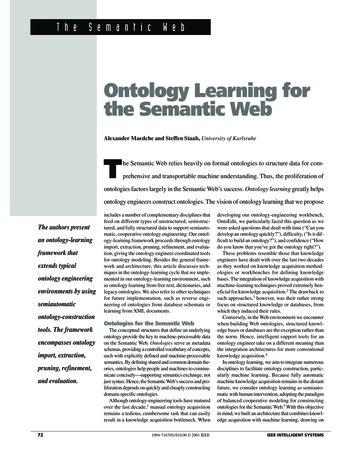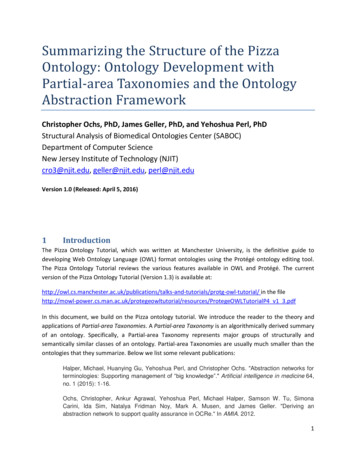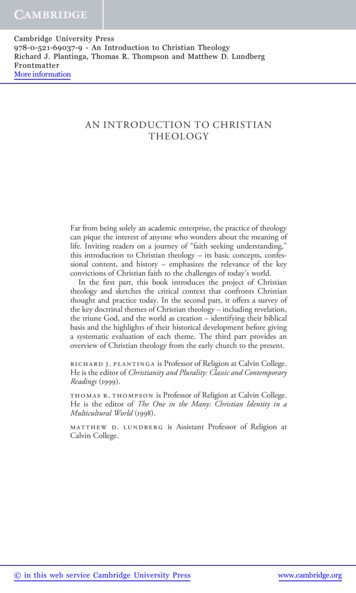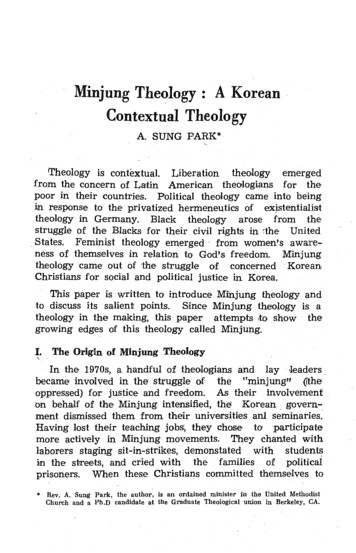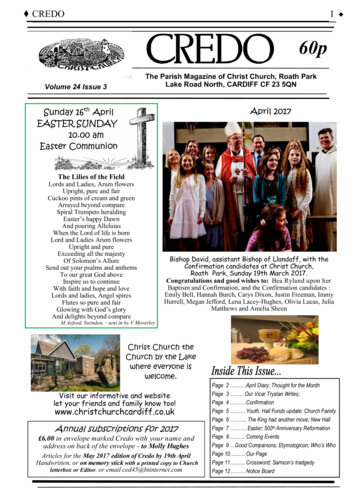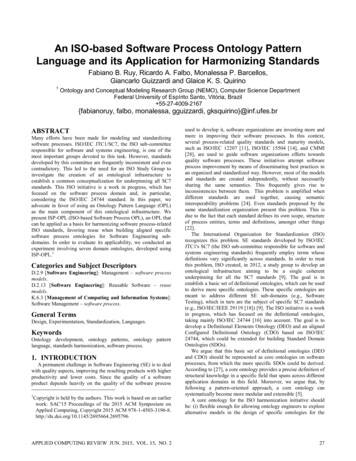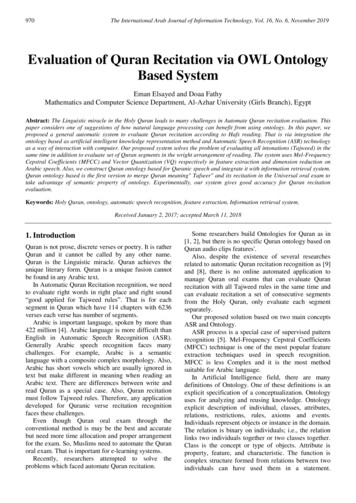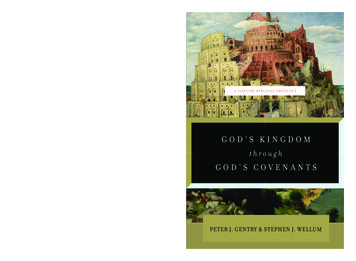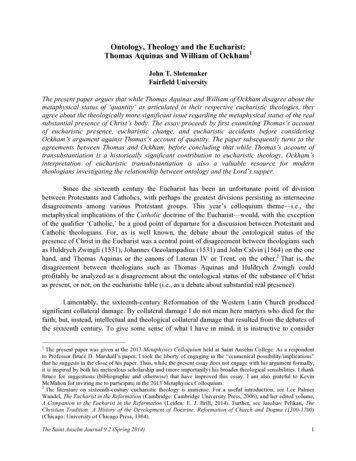
Transcription
Ontology, Theology and the Eucharist:Thomas Aquinas and William of Ockham1John T. SlotemakerFairfield UniversityThe present paper argues that while Thomas Aquinas and William of Ockham disagree about themetaphysical status of ‘quantity’ as articulated in their respective eucharistic theologies, theyagree about the theologically more significant issue regarding the metaphysical status of the realsubstantial presence of Christ’s body. The essay proceeds by first examining Thomas’s accountof eucharistic presence, eucharistic change, and eucharistic accidents before consideringOckham’s argument against Thomas’s account of quantity. The paper subsequently turns to theagreements between Thomas and Ockham, before concluding that while Thomas’s account oftransubstantiation is a historically significant contribution to eucharistic theology, Ockham’sinterpretation of eucharistic transubstantiation is also a valuable resource for moderntheologians investigating the relationship between ontology and the Lord’s supper.Since the sixteenth century the Eucharist has been an unfortunate point of divisionbetween Protestants and Catholics, with perhaps the greatest divisions persisting as internecinedisagreements among various Protestant groups. This year’s colloquium theme—i.e., themetaphysical implications of the Catholic doctrine of the Eucharist—would, with the exceptionof the qualifier ‘Catholic,’ be a good point of departure for a discussion between Protestant andCatholic theologians. For, as is well known, the debate about the ontological status of thepresence of Christ in the Eucharist was a central point of disagreement between theologians suchas Huldrych Zwingli (1531), Johannes Oecolampadius (1531) and John Calvin (1564) on the onehand, and Thomas Aquinas or the canons of Lateran IV or Trent, on the other.2 That is, thedisagreement between theologians such as Thomas Aquinas and Huldrych Zwingli couldprofitably be analyzed as a disagreement about the ontological status of the substance of Christas present, or not, on the eucharistic table (i.e., as a debate about substantial real presence).Lamentably, the sixteenth-century Reformation of the Western Latin Church producedsignificant collateral damage. By collateral damage I do not mean here martyrs who died for thefaith; but, instead, intellectual and theological collateral damage that resulted from the debates ofthe sixteenth century. To give some sense of what I have in mind, it is instructive to consider1The present paper was given at the 2013 Metaphysics Colloquium held at Saint Anselm College. As a respondentto Professor Bruce D. Marshall’s paper, I took the liberty of engaging in the “ecumenical possibility/implications”that he suggests in the close of his paper. Thus, while the present essay does not engage with his argument formally,it is inspired by both his meticulous scholarship and (more importantly) his broader theological sensibilities. I thankBruce for suggestions (bibliographic and otherwise) that have improved this essay. I am also grateful to KevinMcMahon for inviting me to participate in the 2013 Metaphysics Colloquium.2The literature on sixteenth-century eucharistic theology is immense. For a useful introduction, see Lee PalmerWandel, The Eucharist in the Reformation (Cambridge: Cambridge University Press, 2006), and her edited volume,A Companion to the Eucharist in the Reformation (Leiden: E. J. Brill, 2014). Further, see Jarolsav Pelikan, TheChristian Tradition: A History of the Development of Doctrine. Reformation of Church and Dogma (1300-1700)(Chicago: University of Chicago Press, 1984).The Saint Anselm Journal 9.2 (Spring 2014)1
Denys Turner’s discussion of the Eucharist in his recent work Thomas Aquinas: A Portrait.Turner argues that the era of sixteenth-century reform led to the unfortunate situation in whichProtestant and Catholic eucharistic theology tended to be divided by means of an artificialdistinction between the presence of a thing as a “sign” or the presence of a thing as a real“thing.”3 This division between signum and res—to use Augustine’s language—was foreign tothe medieval mind; medieval theologians understood both as essential to eucharistic theologysuch that Thomas would define a sacrament as a “sign that effects what it signifies.”4 Expandinga bit on Turner’s claim, consider Peter Lombard’s organization of the four books of theSentences which followed Augustine’s distinction in De doctrina Christiana between things(res) and signs (signum), and applied that language to eucharistic theology in book IV (i.e., allsigns are things, but not all things are signs).5 In short, I think Turner is correct to note that oneunintended consequence of the sixteenth-century debates was an artificial division between anemphasis on “signs” versus “things” in the development of Protestant and Catholic eucharistictheologies respectively. This, I would argue, is one significant and unintended consequence ofthose heated sixteenth-century debates. But there are others.With respect to eucharistic theology one can note that as a result of the sixteenth-centurydebates a strong antipathy developed in response to fourteenth-century theories. One reason,perhaps, is because Ockham’s eucharistic theology has often been linked with the theology ofMartin Luther. For example, the great German historian of Dogma, Adolph von Harnack, arguedthat in his eucharistic theology, Martin Luther “called in the aid of Occam’s Scholasticism [and] adopted [the] hypothetical speculations of the Nominalists.”6 Whatever the truth of suchstatements, one unfortunate implication of the sixteenth-century reformation of the Church is thatOckham’s eucharistic theology is linked with the Protestant Reformation in such a way that it isconsidered “un-Catholic” in a problematic and, without a doubt, anachronistic way.73Denys Turner, Thomas Aquinas: A Portrait (New Haven, CT: Yale University Press, 2013), p. 242. Turner writes:“Why make the distinction between real presence and presence in a sign into a polarized opposition unless, on someepistemic grounds derived otherwise than from a decent eucharistic theology, the lines of connection between‘presence,’ ‘reality,’ and ‘sign’ have been fractured, the joints dislocated, such that presence as sign and realpresence must needs be opposed to each other? We will, however, get nowhere with Thomas on the Eucharist unlesswe can bracket out what, for him, would have been an entirely misleading way of construing ‘the real’ and ‘the sign’as terms of contrast standing in such mutual exclusion” (pp. 245-46).4Turner, Thomas Aquinas, p. 239.5See Peter Lombard, Sententiae in IV Libris Distinctae, ed. I. Brady, in 3 vol. (Spicilegium Bonaventurianum IVVI) (Grottaferrata: Collegii S. Bonaventurae ad Claras Aquas, 1971 and 1981), book IV, dd. 8-13 (Brady II, pp. 280315).6Adolph von Harnack, History of Dogma, trans. Neil Buchanan, 7 vols. (Boston: Little, Brown and Company,1905), vol. 7, pp. 262 and 264.7The collateral damage produced by the era of sixteenth-century reform is not limited to eucharistic theology.Another unfortunate, and broader sweeping, outcome of the age of reform is the fact that for the past century and ahalf Protestants and Catholics abandoned fourteenth- and fifteenth-century theology more broadly conceived:Protestant theologians viewing it as a period of decadent scholasticism that represented everything that Lutherfought to overturn, while Catholic theologians tended to view it as a theological wasteland that unintentionallyproduced the Protestant Reformation. Thus, as Heiko Oberman argued throughout his career, the fourteenth centuryis claimed by no one. On the complex historiography, see John Inglis, Spheres of Philosophical Inquiry and theHistoriography of Medieval Philosophy (Leiden: E.J. Brill, 1998). Regarding Heiko Oberman’s general approach,see The Harvest of Medieval Theology: Gabriel Biel and Late Medieval Nominalism (Grand Rapids, MI: BakerThe Saint Anselm Journal 9.2 (Spring 2014)2
The present paper will discuss some of the collateral damage that originated with thesixteenth-century Reformation. I will do so by attempting to clear some conceptual space: inparticular, some conceptual space for fourteenth-century eucharistic theology. My intention indoing so is to encourage theologians of disparate ecclesial affiliations to study in depth the richtheological tradition that flourished during the height of the scholastic project. To achieve thisend I will focus on the eucharistic theology of Thomas Aquinas and William of Ockham. I beginwith a short description of Thomas’s eucharistic theology, considering briefly three centralaspects: eucharistic presence, eucharistic change and eucharistic accidents. Second, I willsummarize William of Ockham’s central argument in response to Thomas’s account oftransubstantiation. Third, having discussed some of the disagreements between the positions ofThomas and Ockham, I will argue that regarding the colloquium topic of ‘eucharistic ontology’Thomas and Ockham actually agree about more than they disagree about. Finally, I will concludewith a few remarks on why I think Ockham’s theology in particular, and fourteenth-centurytheology broadly conceived, warrants careful study. In a way, therefore, I am expanding a bit ona theme that Bruce Marshall raised at the end of his paper—the idea of broadening the dialoguepartners, as he did through Scotus, as a means of not only opening up ecumenical dialogue, butalso the discussion within Catholic theology proper.I. Eucharistic Presence, Eucharistic Change, and Eucharistic AccidentsThomas Aquinas developed his theology of the Eucharist in several works, including hisScriptum super libros Sententiarum and the Summa theologiae.8 The following discussion islimited to Thomas’s account as developed in the tertia pars of the Summa theologiae and isselectively focused on the Angelic Doctor’s account of eucharistic presence, eucharistic changeand eucharistic accidents.9Academic, 2000); and The Dawn of the Reformation: Essays in Late Medieval and Reformation Thought (GrandRapids, MI: Wm. B. Eerdmans Publishing Co., 1992).8The Scriptum is published as: Scriptum super libros sententiarum magistri Petri Lombard Episcopi Parisiensis, 4vols., ed. P. Mandonnet and M. F. Moos (Paris: 1929-1947). The Summae Theologiae is found in: Sancti ThomaeAquinatis, doctoris angelici Opera Omnia iussu Leonis XIII. O.M. edita., cura et studio fratrum praedicatorum(Rome: 1882-1996), vols. 4-11. I have used throughout the online edition of the Summa Theologiae found at:www.corpusthomisticum.org. I have also cited the English edition published as, Summa Theologica, 5 vols., trans.by the Fathers of the English Dominican Province (Notre Dame, IN: Ave Maria Press, 1981). For citations of theSumma I give the part, question and article, followed by the page number for the English edition in parentheses.9The literature on Thomas’s eucharistic theology (and medieval eucharistic theology more broadly) is immense.Regarding Thomas, see: Edward Schillebeeckx, L'économie sacramentelle du salut : réflexion théologique sur ladoctrine sacramentaire de saint Thomas, à la lumière de la tradition et de la problématique sacramentellecontemporaine, trans. Benoît-Dominique de la Soujeole (Studia Fribourgensia 95) (Fribourg: Academic Press,2004). For shorter pieces, see Reinhard Hütter, “Transubstantiation Revisited: Sacra Doctrina, Dogma, andMetaphysics,” in Ressourcement Thomism: Sacred Doctrine, the Sacraments, & the Moral Life, ed. Reinhard Hütterand Matthew Levering (Washington DC: The Catholic University of America, 2010), pp. 21-79; Bruce D. Marshall,“The Whole Mystery of Our Salvation: Saint Thomas Aquinas on the Eucharist as Sacrifice,” in RediscoveringAquinas and the Sacraments: Studies in Sacramental Theology, ed. Matthew Levering and Michael Dauphinais(Chicago, IL: Hillenbrand Books, 2009), pp. 39-64.For studies on Medieval eucharistic theology, see: (early medieval) Gary Macy, The Theologies of theEucharist in the Early Scholastic Period: A Study of the Salvific Function of the Sacrament according to theThe Saint Anselm Journal 9.2 (Spring 2014)3
Eucharistic PresenceIn question 76 of the third part of the Summa Theologiae Thomas Aquinas defends thethesis that the entire Christ (totus Christus) is present in the sacrament of the Eucharist.According to Thomas, Christ is present in the Eucharist in a twofold manner: (1) first by thepower of the sacrament (ex vi sacramenti); and (2), second, by natural concomitance (ex naturaliconcomitantia). By means of the power of the sacrament, Thomas argues that “there is under thespecies of this sacrament that into which the pre-existing substance of the bread and wine ischanged.”10 Thus, the words of institution—hoc est corpus meum, hic est sanguis meus—effect asubstantial change, ex vi sacramenti, such that the substance of the bread and wine are convertedinto the body and blood of Christ. The substance of the bread and wine—both their substantialform and their matter—are converted and cease to exist. Second, Thomas argues that by naturalconcomitance there is a real union between the substance of Christ and the accidental propertiesof the host (e.g., the quality and quantity of the host etc.). Thus, the accidents of the host—which, subsequent to the words of institution, persist without the substance of the host—nowpersist by means of natural concomitance ‘over’ the substance of Christ.Thomas argues that as a logical consequence of the claim that the substance of Christ’sbody is present in the sacrament by the power of the sacrament (ex vi sacramenti) and that theaccidental property of Christ’s dimensive quantity is present by means of natural concomitance(ex vi realis concomitantiae), it follows that Christ’s body is present substantively but notdimensionally.11 That is, Christ is substantially present but not accidentally present in terms ofthe accidents’ relation to space: i.e. Christ is not physically present in the same way that a personis normally present in a room. This fact allows Thomas to claim that Christ can be substantiallypresent on the eucharistic table simultaneously in Churches throughout Christendom.Theologians c. 1080-c. 1220 (Oxford: Clarendon Press, 1984); (late medieval) Paul J. J. M. Bakker, “La Raison etLe Miracle: Les Doctrines Eucharistiques (c. 1250- c. 1400.),” PhD Dissertation, Nijmegen, 1999. See also thearticle by Stephen E. Lahey that follows closely the work of Bakker, “Late Medieval Eucharistic Theology,” in ACompanion to the Eucharist in the Middle Ages, ed. Ian Christopher Levy, Gary Macy, and Kristen Van Ausdall(Leiden: E.J. Brill, 2012), pp. 499-540. For a discussion of the Eucharist in the medieval culture, see Miri Rubin,Corpus Christi: The Eucharist in Late Medieval Culture (Cambridge: Cambridge University Press, 1992); andCarolyn Walker Bynum, Wonderful Blood: Theology and Practice in Medieval Northern Germany and Beyond(Philadelphia: University of Pennsylvania Press, 2007).10Thomas, ST. IIIa, q. 76, a. 1 (p. 2449): “Sciendum tamen quod aliquid Christi est in hoc sacramento dupliciter, unomodo, quasi ex vi sacramenti; alio modo, ex naturali concomitantia. Ex vi quidem sacramenti, est sub speciebushuius sacramenti id in quod directe convertitur substantia panis et vini praeexistens, prout significatur per verbaformae, quae sunt effectiva in hoc sacramento sicut et in ceteris, puta cum dicitur, hoc est corpus meum, hic estsanguis meus. Ex naturali autem concomitantia est in hoc sacramento illud quod realiter est coniunctum ei in quodpraedicta conversio terminatur. Si enim aliqua duo sunt realiter coniuncta, ubicumque est unum realiter, oportet etaliud esse, sola enim operatione animae discernuntur quae realiter sunt coniuncta.”11Thomas, ST. IIIa, q. 76, a. 3 (p. 2451): “Respondeo dicendum quod, sicut ex supra dictis patet, quia in hocsacramento substantia corporis Christi est ex vi sacramenti, quantitas autem dimensiva ex vi realis concomitantiae,corpus Christi est in hoc sacramento per modum substantiae, idest, per modum quo substantia est subdimensionibus, non autem per modum dimensionum, idest, non per illum modum quo quantitas dimensiva alicuiuscorporis est sub quantitate dimensiva loci.”The Saint Anselm Journal 9.2 (Spring 2014)4
Clarifying precisely how Christ is substantively present in the Eucharist, Thomas arguesthat Christ is neither circumscriptively (circumscriptive) present nor definitively present(definitive).12 Circumscriptive presence is the presence that an ordinary body consisting of formand matter has with respect to a given place (e.g., the presence of a tree), whereas definitivepresence is the presence that a non-extended body has with respect to a given place (e.g., thepresence of an angel). Thomas argues that Christ is clearly not circumscriptively present in theway that a normal object is present in a place. Further, Thomas argues that Christ is notdefinitively present because, if He were, He would only be “on a particular altar” when thesacrament was performed. Therefore, Thomas concludes that Christ is neither circumscriptivelynor definitively present on the eucharistic table.As Paul Bakker has discussed, theologians such as the Dominican Peter Tarantaise (†1276) and the Franciscan Nicholas of Ockham (†c. 1320) were sympathetic with this account ofeucharistic presence, while others such as John Peckham († 1292), William of Mare (†c. 1285)and Peter John Olivi († 1298) were highly critical.13 Thus, in the late thirteenth and earlyfourteenth century there was a lively and ongoing debate about the philosophical and theologicalaspects of Thomas’s account of eucharistic presence.Eucharistic ChangeThe second topic that must be discussed with respect to Thomas is his account ofeucharistic change. In his analysis of eucharistic presence Thomas stated that the substance ofthe bread and wine were converted into the substance of the body and blood of Christ. Thisposed a potential problem, because according to Aristotle change must occur to a substance. AsStephen Lahey explains,Aristotle’s conception of substance is of a union of form and matter, whichprovides the ontological basis for qualities, quantity, relation, and changes thataffect the being of the substance. So any change that occurs in a thing requiressubstance in which the change takes place.14The implication is that for any change to take place there has to be an underlying substance thatis the object of change. To take a common example, if a red house is painted white, the change incolor must happen to a substance: there must be a substance (i.e., a union of matter and form)that is in fact changed, in this case a house. The problem, as one can anticipate, is that accordingto the doctrine of transubstantiation the substance of the bread and wine cease to exist and aretransformed into the substance of the body and blood of Christ. But, if the substance of the bread12Thomas, ST. IIIa, q. 76, a. 5, ad 1 (p. 2453): “Ad primum ergo dicendum quod corpus Christi non est in hocsacramento definitive, quia sic non esset alibi quam in hoc altari ubi conficitur hoc sacramentum; cum tamen sit et incaelo in propria specie, et in multis aliis altaribus sub specie sacramenti. Similiter etiam patet quod non est in hocsacramento circumscriptive, quia non est ibi secundum commensurationem propriae quantitatis, ut dictum est.”13See Bakker, La Raison et Le Miracle, pp. 40-49.14Lahey, “Late Medieval Eucharistic Theology,” p. 516.The Saint Anselm Journal 9.2 (Spring 2014)5
and wine cease to exist (or are annihilated) there is no persisting medium—i.e., no persistingsubstance or subject—that is the object of change.15Thomas’s solution to the problem is that the substance of the bread and wine are notannihilated, but converted into the substance of Christ’s body. He explains that the substance ofChrist is not immediately present by local motion, but that it is present “by change of thesubstance of bread into [Christ’s body].”16 This change is not a natural change; this eucharisticconversion, Thomas argues, is entirely supernatural and takes place by God’s power alone (solaDei virtute effecta). 17 But, the question remains: is the substance of the bread or wineannihilated? Thomas concludes that the substance of the bread and wine are neither convertedinto their original matter (i.e., the four elements of air, earth, fire and water) nor annihilated.Thomas rejects the idea that the substance of the bread and wine are converted into their originalmatter; for, as he notes, if this were the case one would expect to see some aspect of the fourelements residually present on the eucharistic table (i.e., the observer would expect to see a littleflash of fire, or a little pool of water).18 Further, Thomas is clear that the substance in question isnot annihilated: he writes that “it does not follow that [the substance of the bread] is annihilated . . for it is changed into the body of Christ.”19 The upshot is that there is a true conversion.Thomas presents eucharistic change as a bit of a riddle that encourages and invitestheological commentary. He states first that after consecration of the host the proposition “The15Nota bene: Peter Lombard addressed the problem by arguing that the substance of the bread and wine remains inthe consecrated elements (often called remanentism). For a discussion of Peter Lombard’s eucharistic theology, seeMarcia Colish, Peter Lombard, 2 vols. (Leiden: E. J. Brill, 1994), vol. 2, pp. 551-83. For a broader treatment, seeGary Macy, The Theologies of the Eucharist in the Early Scholastic Period. The Lombard’s eucharistic theology isdeveloped in the fourth book of the Sentences, dd. 8-13 (Brady II, pp. 280-315).16Thomas, ST. IIIa, q. 75, a. 2 (p. 2441): “Non autem aliquid potest esse alicubi ubi prius non erat, nisi per locimutationem, vel per alterius conversionem in ipsum, sicut in domo aliqua de novo incipit esse ignis aut quod illucdefertur, aut quod ibi generatur. Manifestum est autem quod corpus Christi non incipit esse in hoc sacramento permotum localem. Primo quidem, quia sequeretur quod desineret esse in caelo, non enim quod localiter movetur,pervenit de novo ad aliquem locum, nisi deserat priorem. Secundo, quia omne corpus localiter motum pertransitomnia media, quod hic dici non potest. Tertio, quia impossibile est quod unus motus eiusdem corporis localiter motiterminetur simul ad diversa loca, cum tamen in pluribus locis corpus Christi sub hoc sacramento simul esse incipiat.Et propter hoc relinquitur quod non possit aliter corpus Christi incipere esse de novo in hoc sacramento nisi perconversionem substantiae panis in ipsum.”17Thomas, ST. IIIa, q. 75, a. 4 (pp. 2443-44): “Haec tamen conversio non est similis conversionibus naturalibus, sedest omnino supernaturalis, sola Dei virtute effecta Non igitur solum potest perficere conversionem formalem, utscilicet diversae formae sibi in eodem subiecto succedant, sed conversionem totius entis, ut scilicet tota substantiahuius convertatur in totam substantiam illius. Et hoc agitur divina virtute in hoc sacramento. Nam tota substantiapanis convertitur in totam substantiam corporis Christi, et tota substantia vini in totam substantiam sanguinis Christi.Unde haec conversio non est formalis, sed substantialis. Nec continetur inter species motus naturalis, sed proprionomine potest dici transubstantiatio.”18Thomas, ST. IIIa, q. 75, a. 3 (p. 2442): “Praeiacens autem materia in quam corpora mixta resolvi possunt, suntquatuor elementa, non enim potest fieri resolutio in materiam primam, ita quod sine forma existat, quia materia sineforma esse non potest. Cum autem post consecrationem nihil sub speciebus sacramenti remaneat nisi corpus etsanguis, oportebit dicere quod elementa in quae resoluta est substantia panis et vini, inde discedant per motumlocalem. Quod sensu perciperetur.”19Thomas, ST. IIIa, q. 75, a. 3, ob. 1 (p. 2443): “Non tamen sequitur quod annihiletur, convertitur enim in corpusChristi.”The Saint Anselm Journal 9.2 (Spring 2014)6
substance of the bread is something” is false. Conversely stated, after the consecration of the hostit is true to state that the substance of the bread and wine are nothing. Further, Thomas states thatthat into which the substance of the bread is changed into is some thing (aliquid). That is, there issome thing—some res—that the substance of the bread and wine become. Therefore, despite thefact that the substance of the bread is no longer a thing (res), it does not follow that the substanceis annihilated (annihilata).20 While this seems at first like a distinction without a difference, thetheological point here is that the substance of the bread and wine are not annihilated butconverted into another substance.Eucharistic AccidentsAs noted above, Thomas argues that eucharistic change consists of a substantial changesuch that the substance of the bread and wine are converted into the substance of the body ofChrist. But, as medieval theologians realized, this posed the particularly difficult problem ofexplaining how the accidents of the bread and wine are observed, touched and tasted bycelebrants. In short, how do the accidental properties of bread and wine persist given that thesubstance ceases to exist? In distinction 12 of the fourth book of the Sentences, Peter Lombardargued that the accidents of bread and wine persist without a subject. He writes:If it is asked about the accidents which remain, namely species, taste, and weight,in what subject they inhere, it seems to me to be better to profess that they existwithout a subject than that they are in a subject; because there is no substancethere, apart from that of the Lord’s body and blood, which is not joined to thoseaccidents.21The Lombard’s solution, therefore, was to simply argue that the accidents of bread and winepersist without a subject; in fact, the Lombard is quite specific about it, claiming that theaccidents subsist through themselves (per se subsistentia).22 This somewhat simplistic, albeitstraightforward, solution to the problem was rejected by Thomas.23Thomas argues that the subject (subiectum) of the accidents (e.g. the color, taste, smell,etc.) of the bread and wine is not the substance of the bread and wine—as the substance of thebread and wine has been converted into the substance of the body of Christ—but instead the20Thomas, ST. IIIa, q. 75, a. 3, ob. 3 (p. 2443): “Ad tertium dicendum quod, licet post consecrationem haec sit falsa‘substantia panis est aliquid’; id tamen in quod substantia panis conversa est, est aliquid. Et ideo substantia panisnon est annihilata.”21Lombard, Sent. IV, d. 12, c. 1 (Brady II, p. 3043-7): “Si autem quaeritur de accidentibus quae remanent, scilicet despeciebus et sapore et pondere, in quo subiecto fundentur, potius mihi videtur fatendum exsistere sine subiecto,quam esse in subiecto; quia ibi non est substantia nisi corporis et sanguinis dominici, quae non afficitur illisaccidentibus.” See the translation by Giulio Silano, The Sentences, Book IV, On the Doctrine of Signs (Toronto:Pontifical Institute of Mediaeval Studies, 2010), p. 60.22Lombard, Sent. IV, d. 12, c. 1 (Brady II, p. 3048-11).23On the question of whether or not the accidents remain in the sacrament without a subject, see Thomas, ST. IIIa, q.77, a. 1 (pp. 2456-57).The Saint Anselm Journal 9.2 (Spring 2014)7
dimensive quantity (quantitas dimensivae) of the bread and wine. 24 Following Aristotle’sCategories, Thomas argues that the composition of things consists of substance and ninecategories of accidental being. Accidents, as Thomas notes, generally inhere in a substance; thatsaid, if the substance of a thing no longer persists, Thomas argues that God can bring it about byan act of his divine power (virtute divina) 25 that an accident exists by itself such that it functionsas the subject of other accidents.26 The accident that functions in this particular way (i.e., as asubject of the other accidents), according to Thomas, is quantity. The upshot is that for Thomasthe dimensive quantity of the bread truly subsists and persists while the other eucharisticaccidents (e.g., the color, texture, smell, and taste of the bread) inhere in it.27 To borrow a termfrom Stephen Lahey, according to Thomas the quantity of the bread functions as a ‘substanceproxy’ for the other accidents, such that it is the subject of the other accidents.28Finally, regarding Christ’s accidents, which are not experientially present on the altar,Thomas argues that because the whole Christ is present, his accidents are present by naturalconcomitance. Thomas will argue that “not only the flesh, but the entire body of Christ, that is,his bones, the nerves, and the like” are present.29 And, as if to clarify the matter explicitly, hewrites that “by reason of real concomitance the whole dimensive quantity of Christ’s body andall its other accidents (et omnia alia accidentia) are in this sacrament.”30 Therefore, Christ—thewhole Christ (totus Christus) consisting of both his substance and all of His accidents—ispresent on the eucharistic table.24Thomas, ST. IIIa, q. 77, a. 2, sed contra (p. 2458): “Sed contra est quod qualitates non sunt divisibiles nisi peraccidens, scilicet ratione subiecti. Dividuntur autem qualitates remanentes in hoc sacramento per divisionemquantitatis dimensivae, sicut patet ad sensum. Ergo quantitas dimensiva est subiectum accidentium quae remanent inhoc sacramento.”25Thomas, ST. IIIa, q. 77, a. 1 (p. 2457): “Et ideo relinquitur quod accidentia in hoc sacramento manent sinesubiecto. Quod quidem virtute divina fieri potest. Cum enim effectus magis dependeat a causa prima quam a causasecunda, potest Deus, qui est prima causa substantiae et accidentis, per suam infinitam virtutem conservare in esseaccidens subtracta substantia, per quam conservabatur in esse sicut per propriam causam, sicut etiam ali
The Saint Anselm Journal 9.2 (Spring 2014) 4 Eucharistic Presence In question 76 of the third part of the Summa Theologiae Thomas Aquinas defends the thesis that the entire Christ (totus Christus) is present in the sacrament of the Eucharist.According to Thomas, Christ is present in the Eucharist in a twofold manner: (1) first by the


